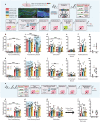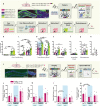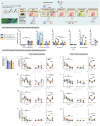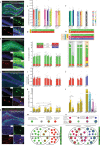Reactivating hippocampal-mediated memories during reconsolidation to disrupt fear
- PMID: 36096993
- PMCID: PMC9468169
- DOI: 10.1038/s41467-022-32246-8
Reactivating hippocampal-mediated memories during reconsolidation to disrupt fear
Abstract
Memories are stored in the brain as cellular ensembles activated during learning and reactivated during retrieval. Using the Tet-tag system in mice, we label dorsal dentate gyrus neurons activated by positive, neutral or negative experiences with channelrhodopsin-2. Following fear-conditioning, these cells are artificially reactivated during fear memory recall. Optical stimulation of a competing positive memory is sufficient to update the memory during reconsolidation, thereby reducing conditioned fear acutely and enduringly. Moreover, mice demonstrate operant responding for reactivation of a positive memory, confirming its rewarding properties. These results show that interference from a rewarding experience can counteract negative affective states. While memory-updating, induced by memory reactivation, involves a relatively small set of neurons, we also find that activating a large population of randomly labeled dorsal dentate gyrus neurons is effective in promoting reconsolidation. Importantly, memory-updating is specific to the fear memory. These findings implicate the dorsal dentate gyrus as a potential therapeutic node for modulating memories to suppress fear.
© 2022. The Author(s).
Conflict of interest statement
The authors declare no competing interests.
Figures








Similar articles
-
Engram Size Varies with Learning and Reflects Memory Content and Precision.J Neurosci. 2021 May 5;41(18):4120-4130. doi: 10.1523/JNEUROSCI.2786-20.2021. Epub 2021 Apr 22. J Neurosci. 2021. PMID: 33888604 Free PMC article.
-
Optogenetic stimulation of a hippocampal engram activates fear memory recall.Nature. 2012 Mar 22;484(7394):381-5. doi: 10.1038/nature11028. Nature. 2012. PMID: 22441246 Free PMC article.
-
Increasing the GluN2A/GluN2B Ratio in Neurons of the Mouse Basal and Lateral Amygdala Inhibits the Modification of an Existing Fear Memory Trace.J Neurosci. 2016 Sep 7;36(36):9490-504. doi: 10.1523/JNEUROSCI.1743-16.2016. J Neurosci. 2016. PMID: 27605622 Free PMC article.
-
Inception of a false memory by optogenetic manipulation of a hippocampal memory engram.Philos Trans R Soc Lond B Biol Sci. 2013 Dec 2;369(1633):20130142. doi: 10.1098/rstb.2013.0142. Print 2014 Jan 5. Philos Trans R Soc Lond B Biol Sci. 2013. PMID: 24298144 Free PMC article. Review.
-
Hippocampal Engrams and Contextual Memory.Adv Neurobiol. 2024;38:45-66. doi: 10.1007/978-3-031-62983-9_4. Adv Neurobiol. 2024. PMID: 39008010 Free PMC article. Review.
Cited by
-
Gaze-centered gating, reactivation, and reevaluation of economic value in orbitofrontal cortex.Nat Commun. 2024 Jul 22;15(1):6163. doi: 10.1038/s41467-024-50214-2. Nat Commun. 2024. PMID: 39039055 Free PMC article.
-
Not the same as it ever was: A review of memory modification, updating, and distortion in humans and rodents.Neurosci Biobehav Rev. 2025 Jul;174:106195. doi: 10.1016/j.neubiorev.2025.106195. Epub 2025 May 3. Neurosci Biobehav Rev. 2025. PMID: 40324709 Review.
-
Dominant activities of fear engram cells in the dorsal dentate gyrus underlie fear generalization in mice.PLoS Biol. 2024 Jul 12;22(7):e3002679. doi: 10.1371/journal.pbio.3002679. eCollection 2024 Jul. PLoS Biol. 2024. PMID: 38995985 Free PMC article.
-
How Fear Memory is Updated: From Reconsolidation to Extinction?Neurosci Bull. 2025 Jun;41(6):1054-1084. doi: 10.1007/s12264-025-01367-7. Epub 2025 Apr 9. Neurosci Bull. 2025. PMID: 40205305 Free PMC article. Review.
-
Aversive memories can be weakened during human sleep via the reactivation of positive interfering memories.Proc Natl Acad Sci U S A. 2024 Jul 30;121(31):e2400678121. doi: 10.1073/pnas.2400678121. Epub 2024 Jul 25. Proc Natl Acad Sci U S A. 2024. PMID: 39052838 Free PMC article.
References
Publication types
MeSH terms
Grants and funding
LinkOut - more resources
Full Text Sources
Molecular Biology Databases

